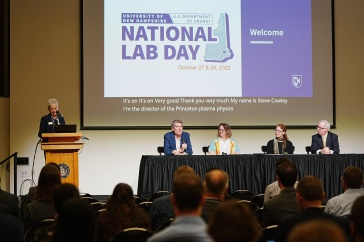
Kenneth Johnson, senior demographer at the Carsey Institute and professor of sociology at UNH
New Hampshire’s population growth has slowed to its smallest gains since the 1950s because fewer people are moving to the state. New Hampshire also will soon see a rapid increase in its older population, according to a new, extensive report about the state’s demographic trends from the Carsey Institute at the University of New Hampshire in partnership with the New Hampshire Endowment for Health and the New Hampshire Charitable Foundation.
The new research is presented in the report “New Hampshire Demographic Trends in the Twenty-First Century,” authored by Kenneth Johnson, senior demographer at the Carsey Institute and professor of sociology at UNH.
“The demographic trends under way in New Hampshire present both challenges and opportunities. Migrants contribute to the well-being of the state by providing human capital that enhances the workforce and contributes to the state’s social, intellectual, and economic life. However, the aging of the state’s population over the next several decades will put considerable pressure on the financial resources of state and local governments,” Johnson said.
“Furthermore, the spatial disparities in age, diversity, education, income, and poverty across the state will present significant challenges for government, businesses, and nonprofits,” he said.
The key research findings are as follows:
- New Hampshire’s population increased by 80,700 between 2000 and 2010, mostly during the earlier years of the decade.
- The recession dramatically reduced the number of migrants coming to the state.
- Migration contributed 35,400 to the population gain; far fewer than in earlier decades. The excess of births over deaths also diminished to just 45,300.
- Some areas of New Hampshire continue to grow rapidly, while others are losing population.
- New Hampshire currently does not have a large population of seniors, but a rapid increase in the older population is inevitable and coming soon.
- Racial diversity is growing in New Hampshire, but remains modest and concentrated in a few areas of the state.
- Minority gains are greatest among children; 12.2 percent of the state’s children are minority compared to just 6.4 percent of adults.
- Demographic change is producing both challenges and opportunities for the state.
- Fewer migrants to the state will have an immediate financial impact on the state and implications for its future human, intellectual, and social capital.
- Population aging will increase the cost of providing state and local services.
- A growing population of minority children heightens the need for appropriate public policy responses to address their needs.Pockets of high child poverty exist in New Hampshire despite the lowest state poverty rates in the nation.

Population change in New Hampshire, 2000 to 2010
Research on this project was funded by grants from the New Hampshire Endowment for Health and the New Hampshire Charitable Foundation. Additional support for this research was provided by the New Hampshire Agricultural Experiment Station and by grants to the University of New Hampshire from the Annie E. Casey Foundation, the W. K. Kellogg Foundation, and an anonymous donor.
Figures
Population change in New Hampshire, 2000 to 2010
New Hampshire demographic change, 1970 to 2010
New Hampshire age structure change, 1990 to 2010
Population Change in New Hampshire from 1990 to 2010
-
Written By:
Lori Tyler Gula, PhD | NH Agricultural Experiment Station | lori.gula@unh.edu | 603-862-1452
















































